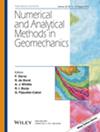Transient Analysis of a Poroelastic Soil Layer Due to Horizontal Movement of a Rigid Disk Attached on the Layer With a Relaxed Boundary Condition
Abstract
This paper is concerned with the study of a poroelastic soil layer under impulsive horizontal loading. Building upon Biot's general theory of poroelasticity, a comprehensive set of governing equations addressing three-dimensional transient wave propagation problem are established. Explicit general solutions for displacements and pore-pressures are derived by employing a sophisticated mathematical approach, incorporating decoupling transformation, Fourier series expansion, and Laplace–Hankel integral transform techniques. Subsequently, physical-domain components are numerically obtained by an enhanced Durbin method coupled with inverse Hankel transform. Comparisons the existing transient solutions for the ideal elastic half-space are made to validate the proposed formulations' reliability and precision. Through representative analyses for time-domain results, it is illustrated to study the influence of the soil thickness and types of loading pulse on the transient dynamic response of finite-thickness poroelastic soil layers. The results in comparative analysis show that the magnitudes of the horizontal displacement and pore water pressure can be affected and become more fluctuant when the thickness of the poroelastic soil layer decreases. The basic solutions may be attributed to a variety of wave propagation problems due to transient dynamic loading and illustrate the corresponding distinct wave features elegantly.

 求助内容:
求助内容: 应助结果提醒方式:
应助结果提醒方式:


